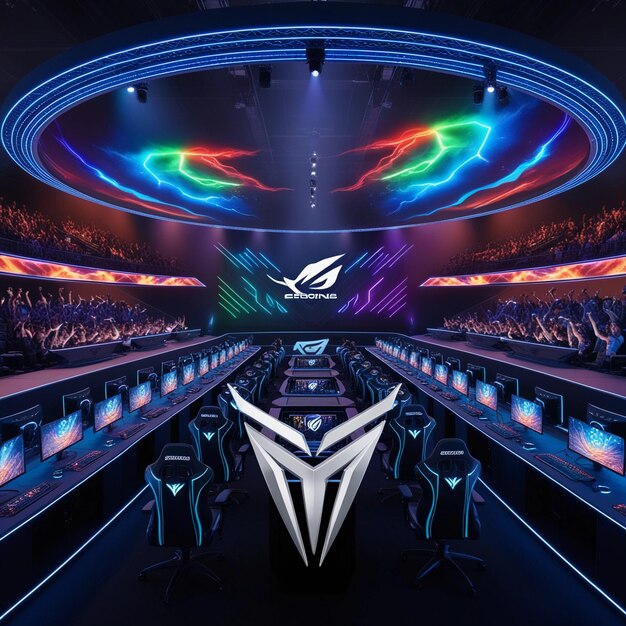Esports Tournament Prize Pools: Highest ROI Games in 2025

Analyzing Esports Tournament Prize Pools: Which Games Offer the Highest ROI in 2025? reveals a dynamic landscape where strategic investment in top-tier titles like Dota 2, League of Legends, and Counter-Strike continues to yield significant returns for professional players and organizations.
In the rapidly evolving landscape of competitive gaming, understanding Esports Tournament Prize Pools: Which Games Offer the Highest ROI in 2025? is crucial for aspiring professionals, team owners, and investors alike. The stakes are higher than ever, with prize money reaching astronomical figures, transforming gaming into a legitimate and highly lucrative career path. This guide delves into the current trends, what to expect in the coming years, and identifies the games that are likely to deliver the best return on investment.
The Evolving Landscape of Esports Prize Pools
The global esports ecosystem has witnessed explosive growth over the past decade, with prize pools expanding significantly. What started as modest sums has escalated into multi-million dollar spectacles, reflecting the industry’s burgeoning popularity and commercial viability. This expansion is driven by increasing viewership, corporate sponsorships, and dedicated fan bases.
Understanding the current structure and historical trajectory of these prize pools is essential. Games like Dota 2 and League of Legends have consistently dominated headlines with their record-breaking winnings, but emergent titles and genres are beginning to carve out their own substantial niches. The sheer scale now means that a single tournament can represent a life-changing sum for competitors, making the choice of which game to pursue a critical career decision.
Historical Growth and Key Drivers
The growth of esports prize pools isn’t accidental; it’s the result of several intertwined factors. Initially, prize money was often self-funded by tournament organizers or game developers. Over time, external investments from non-endemic brands, media rights deals, and innovative crowdfunding initiatives have dramatically amplified financial rewards.
- Developer Investment: Game developers like Valve and Riot Games directly contribute massive sums and invest heavily in their competitive scenes.
- Sponsorships and Advertisements: Major brands from tech to automotive industries are pouring money into esports, seeing it as a prime channel to reach younger, tech-savvy demographics.
- Crowdfunding: Innovative models, such as Dota 2’s Battle Pass, allow players to contribute directly to the tournament prize pool, creating truly community-driven financial incentives.
- Media Rights Deals: Increasingly, broadcasters and streaming platforms are paying substantial sums for exclusive rights to esports content, further enriching the ecosystem.
This multifaceted financial input ensures a robust and expanding prize pool environment, attracting top talent and accelerating the professionalization of the industry. The competitive landscape is now a viable career path, rather than just a hobby.
The Impact of Global Events and Technology
Global events, including technological advancements and shifts in audience behavior, continually reshape the esports prize pool environment. The rise of streaming platforms has democratized access to esports, allowing events to reach millions worldwide, regardless of geographical barriers. This widespread accessibility directly translates to larger audiences, which in turn attracts more sponsors and increases prize money.
Furthermore, innovations in game design and esports infrastructure continuously push the boundaries. Better spectator modes, enhanced in-game economies, and more sophisticated anti-cheat systems contribute to a healthier competitive scene, solidifying the appeal for both players and investors. The synergy between technological evolution and expanding viewership ensures that prize pools are likely to continue their upward trajectory into 2025 and beyond.
In conclusion, the evolution of esports prize pools reflects a maturing industry, driven by significant investment, strategic partnerships, and a dedicated global fanbase. This robust foundation sets the stage for a compelling analysis of which games will offer the highest return on investment in the coming year.
Dota 2: The Reigning King of Prize Pools
When discussing monumental prize pools in esports, Dota 2 consistently stands at the apex. Developed by Valve Corporation, this multiplayer online battle arena (MOBA) title has become synonymous with record-breaking prize money, primarily through its flagship annual tournament, The International. For years, The International has dwarfed prize pools of other esports events, cementing Dota 2’s reputation as a top-tier game for potential earnings.
The unique crowdfunding model employed by Valve plays a critical role in these massive accumulations. Players purchase a “Battle Pass” or “Compendium,” and a significant percentage of these sales directly contributes to The International’s prize pool. This community-driven approach fosters deep engagement and directly incentivizes the game’s flourishing competitive scene, making it a prime candidate for high ROI in 2025.

The International: A Legacy of Record-Breaking Winnings
The International is not just a tournament; it’s a spectacle, a cultural event in the esports calendar. Its prize pools regularly exceed tens of millions of dollars, with the peak reaching over $40 million in 2021. For players, winning The International means instant millionaire status, a level of financial reward almost unparalleled in traditional sports.
- Unmatched Prize Amounts: Consistently boasts the largest single tournament prize pools in esports history.
- Global Reach: Attracts teams and viewers from every corner of the globe, solidifying its international appeal.
- Consistent Performance: Despite other games growing, Dota 2 maintains strong prize pool figures year after year.
- Tiered Tournament System: Beyond The International, the Dota Pro Circuit (DPC) offers substantial prize money through regional leagues and majors, providing steady income opportunities.
The prestige associated with The International also translates into significant sponsorship opportunities and brand deals for successful players and teams, amplifying the overall financial return. This ecosystem ensures that skilled Dota 2 players are well-compensated throughout their careers.
Player Salaries and Endorsements
Beyond the tournament winnings, professional Dota 2 players often command impressive salaries from their organizations. Top-tier teams invest heavily in their rosters, providing stable income, benefits, and support staff. These salaries, combined with prize money, create a highly attractive financial package.
Furthermore, successful Dota 2 players frequently secure lucrative endorsement deals with gaming peripheral companies, energy drink brands, and other corporate entities. Their large fan bases and high visibility make them valuable assets for marketing campaigns. The combination of prize pools, salaries, and endorsements positions Dota 2 as a leading title for financial ROI in the competitive gaming sphere, a trend expected to continue robustly into 2025 as the game sustains its immense popularity and dedicated player base.
League of Legends: A Global Juggernaut
League of Legends, often referred to as LoL, stands as another colossal figure in the esports world, particularly concerning its prize pools and global reach. Developed by Riot Games, this MOBA title has cultivated an unprecedented professional ecosystem, characterized by structured regional leagues, international tournaments, and a massive, dedicated fanbase. While its single tournament prize pools might not always eclipse Dota 2’s The International, LoL’s consistency, global presence, and overall ecosystem make it an incredibly strong contender for high ROI in 2025.
Riot Games has meticulously built a franchised league system, stabilizing player incomes and providing clear career paths. This structure includes regional championships and culminates in the annual World Championship, an event that draws tens of millions of viewers and boasts substantial prize money, complemented by in-game revenue sharing that benefits participating teams.
The World Championship and MSI
The League of Legends World Championship, or “Worlds,” is the pinnacle of competitive LoL. It’s an event of immense scale and prestige, watched by audiences comparable to traditional sports finales. While the prize pools for Worlds are inherently large, they are often augmented by a portion of in-game skin sales, similar to Dota 2’s Compendium model but integrated differently into the game’s economy.
- Consistent High Stakes: Worlds consistently offers multi-million dollar prize pools.
- Mid-Season Invitational (MSI): Another significant international tournament that offers substantial winnings and global exposure.
- Franchised League System: Regional leagues like the LCS (North America), LEC (Europe), LCK (Korea), and LPL (China) provide regular income for players and teams.
- Brand Value: The sheer popularity of LoL ensures high sponsorship interest, adding to organizational and player income.
The structured nature of LoL’s competitive scene provides more consistent earning opportunities throughout the year compared to some other esports, where earnings might be more heavily concentrated in one major annual event. This predictability is a huge advantage for players seeking a stable professional career.
Stability and Player Development
Riot Games’ commitment to formalized leagues and player development fosters a stable environment for professional players. Teams in franchised leagues receive financial support, allowing them to offer competitive salaries, top-tier coaching, and state-of-the-art facilities. This investment in player welfare and infrastructure ensures that talent is nurtured and retained within the ecosystem.
Beyond direct prize money and salaries, the massive global viewership of League of Legends esports translates into significant personal branding opportunities for professional players. Top players become celebrities within the gaming community, leading to lucrative streaming careers, personal sponsorships, and expanded media appearances. This multi-faceted income generation makes League of Legends an undeniable powerhouse in terms of ROI for players and organizations well into 2025, thanks to its robust commercial model and sustained global appeal.
Counter-Strike 2: The Enduring FPS Colossus
The competitive first-person shooter (FPS) scene has been dominated by one title for decades: Counter-Strike. With the recent transition to Counter-Strike 2 (CS2), the game continues its legacy as a top-tier esport, offering significant prize pools and a robust professional circuit. Developed by Valve, CS2 retains the core gameplay that has captivated millions while introducing graphical and technical enhancements that promise to keep its competitive edge sharp.
CS2’s prize pools are spread across numerous tournaments organized by various third-party entities, culminating in Valve-sponsored “Majors.” These events consistently offer multi-million dollar prize pools, attracting a global array of highly skilled teams and creating intense rivalries. The enduring popularity and consistent high stakes make CS2 a strong contender for significant ROI for players and organizations in 2025.
Major Tournaments and Global Circuit
Unlike Dota 2 or League of Legends, where the developer largely steers the entire circuit, CS2 benefits from a decentralized tournament structure. This means a variety of prestigious third-party organizers like ESL, BLAST, and PGL host major events, each with substantial prize money. These events feed into a global ranking system, with the Valve-sponsored Majors being the pinnacle.
- Diverse Tournament Organizers: Multiple event organizers contribute to a dynamic and competitive circuit.
- Million-Dollar Majors: Valve-sponsored Majors consistently feature prize pools of $1 million or more.
- Consistent Activity: The decentralized nature means there are numerous high-stakes tournaments throughout the year.
- Strong Grassroots Scene: A flourishing amateur and semi-professional scene feeds talent into the top tiers.
The sheer volume and prestige of these tournaments ensure that top CS2 teams and players have consistent opportunities to earn significant prize money. This widespread distribution of prize pools across multiple events provides more frequent high-value earning potential.
Esports Ecosystem and Player Security
The CS2 esports ecosystem is one of the most mature and well-established in competitive gaming. Top organizations invest heavily in their CS2 rosters, offering competitive salaries, dedicated support staff, and stable contracts. This structure provides a level of financial security for professional players beyond just tournament winnings, which is critical for long-term career viability.
Moreover, the game’s long-standing history and global fanbase translate into strong brand affinity for professional players. Many CS2 pros have built significant personal brands, leading to lucrative streaming careers on platforms like Twitch, sponsored content deals, and partnerships with gaming peripheral companies. The transition to CS2 has reinvigorated interest, signalling continued strong investment and high ROI potential for players and teams through 2025 and beyond.
Emerging Titles and Niche Markets: Where to Look for Future ROI
While established giants like Dota 2, League of Legends, and Counter-Strike 2 consistently deliver high prize pools, the dynamic nature of esports means that new and emerging titles frequently offer compelling opportunities for future return on investment. These “niche” markets or rising stars might not boast the same top-tier prize money initially, but they often present lower barriers to entry and faster tracks to the top for skilled players. Identifying these games early can be a strategic move for aspiring pros and savvy investors looking for growth opportunities in 2025.
Some games that exhibit strong growth potential often belong to genres experiencing renewed popularity or introduce innovative gameplay mechanics that capture a dedicated audience. Investing time and resources into these titles before they reach peak saturation can lead to significant dividends as their competitive scenes mature and prize pools expand.

Valorant: A Rising FPS Contender
Riot Games’ tactical shooter, Valorant, has rapidly established itself as a major player in the esports scene since its release. Combining precise gunplay with agent-based abilities, it has attracted a massive player base and viewership. Riot has invested significantly in building a global franchised league system similar to League of Legends, ensuring stability and professional opportunities.
Valorant’s prize pools, while not yet rivaling Dota 2’s peak, are consistently in the millions for its major VCT (Valorant Champions Tour) events like Champions and Masters. The game’s strong developer support, growing international appeal, and structured competitive ecosystem position it as a prime candidate for increasing ROI in 2025. It offers a fresh alternative for FPS enthusiasts looking for a dedicated path to professional play with strong financial backing.
Mobile Esports: The Untapped Potential
The rise of mobile gaming has been nothing short of phenomenal, and mobile esports is following suit. Games like PUBG Mobile, Mobile Legends: Bang Bang, and Free Fire command staggering player numbers, especially in Asian and South American markets. Their prize pools, while perhaps less publicized in Western media, are already reaching multi-million dollar figures for their world championships.
- Massive Player Base: Mobile games boast billions of players worldwide, driving huge potential for viewership.
- Accessibility: Lower hardware requirements make mobile esports accessible to a broader global audience.
- Developer Investment: Major developers are pouring resources into building robust competitive circuits for their mobile titles.
- Regional Dominance: Particularly strong in developing markets, where mobile is the primary gaming platform.
For players and organizations targeting ROI, mobile esports presents a unique opportunity in 2025. The competitive landscape is still maturing, offering chances to establish dominance, especially in regions with burgeoning mobile gaming populations. The lower entry barrier compared to PC titles can also make it an attractive avenue for new talent.
In summary, while the established games provide reliable high returns, keeping an eye on emerging titles and specialized segments like mobile esports is crucial for identifying future high-ROI opportunities. These markets are often characterized by rapid growth and less saturated competitive fields, offering a strategic advantage for early adopters and dedicated players.
Factors Influencing ROI: Beyond Just Prize Money
When assessing Esports Tournament Prize Pools: Which Games Offer the Highest ROI in 2025?, it’s crucial to look beyond just the raw prize money figures. While a large prize pool is certainly attractive, the overall return on investment for players, teams, and investors encompasses a broader range of factors. These include the stability of the game’s ecosystem, developer support, viewership numbers, talent accessibility, and the long-term viability of the title itself. A holistic view ensures a more accurate assessment of potential earnings and career longevity.
A game might have an enormous single tournament prize pool, but if the professional scene is unstable, or if there are few opportunities outside that one event, the overall ROI can be diminished. Conversely, a game with consistently good prize pools across multiple events, strong player salaries, and diverse income streams can offer a more stable and ultimately higher return over time.
Game Stability and Developer Support
The longevity and health of an esports title’s competitive scene are heavily dependent on the game’s stability and the developer’s commitment. A game that receives consistent updates, balances, and anti-cheat measures retains its player base and competitive integrity. Developers who actively invest in their esports circuits, provide financial backing, and communicate openly with their communities tend to foster more stable and rewarding environments.
- Consistent Updates: Regular content and balance patches keep the game fresh and engaging.
- Anti-Cheat Systems: Robust anti-cheat measures ensure fair play, crucial for competitive integrity.
- Financial Investment: Direct funding from developers into tournaments and league structures stabilizes the scene.
- Community Engagement: Developers who listen to and interact with their player base build loyalty and foster growth.
Without strong developer support, even a popular game can struggle to maintain a vibrant competitive circuit. A game with long-term developer commitment often signals a safer and more profitable investment for players and organizations.
Viewership, Sponsorships, and Player Salaries
High viewership is a critical determinant of a game’s ROI potential. Large audiences attract sponsors, media partners, and advertisers, who in turn inject more money into the ecosystem through sponsorships and media rights deals. These funds directly contribute to bigger prize pools, higher player salaries, and more opportunities for teams.
Furthermore, player salaries and endorsement deals represent a significant portion of a professional’s total earnings. Games with established franchised leagues, like League of Legends and Valorant, offer more stable income streams through guaranteed salaries. Individual player brands also play a role, with popular pros securing deals for peripherals, merchandise, and personal sponsorships beyond their team contracts. Therefore, a game with a strong viewership, a vibrant sponsorship market, and reliable player compensation mechanisms offers a more comprehensive and attractive ROI than one solely reliant on peak prize pool numbers.
Navigating the Esports Career Path: Maximize Your ROI
For aspiring professionals and new teams seeking to enter the esports arena, understanding how to maximize their return on investment (ROI) extends beyond simply picking the game with the largest prize pool. It involves strategic career planning, skill development, network building, and smart financial management. A successful esports career, much like any high-performance endeavor, requires dedication, continuous learning, and a keen awareness of the industry’s evolving dynamics.
Maximizing ROI means not only aiming for direct tournament winnings but also capitalizing on salary potential, sponsorship opportunities, and personal brand development. In 2025, the esports landscape offers more diverse income streams than ever before, making a multi-faceted approach essential for sustained success.
Skill Development and Specialization
At the core of any successful esports career is exceptional skill. Dedicating thousands of hours to mastering a game is non-negotiable. However, beyond raw mechanics, skill development in esports also involves game knowledge, strategic thinking, teamwork, and mental fortitude. Specializing in specific roles or champions within a game can also provide a competitive edge, making an individual more valuable to a team. Continuous self-improvement is key, as the competitive meta of most esports titles is constantly shifting.
- Consistent Practice: Thousands of hours dedicated to honing mechanical skills and game sense.
- Strategic Analysis: Deep understanding of game mechanics, meta-trends, and opponent strategies.
- Teamwork and Communication: Essential soft skills for collaborative team-based games.
- Mental Resilience: Ability to perform under pressure and bounce back from setbacks.
Investing time in analyzing professional gameplay, reviewing one’s own matches, and seeking coaching or mentorship can significantly accelerate skill development and increase one’s chances of reaching the top tier.
Building a Personal Brand and Networking
In the modern esports era, a strong personal brand is almost as important as in-game skill. Streaming on platforms like Twitch and YouTube, engaging with fans on social media, and creating compelling content can open up numerous income streams outside of direct tournament winnings. A strong personal brand attracts sponsors, increases visibility for recruiting teams, and builds a dedicated fanbase that can support a player’s career through subscriptions and donations.
Networking within the esports community is equally vital. Connecting with other players, coaches, managers, and industry professionals can lead to opportunities for team tryouts, substitute roles, or even broadcasting and analytical positions if a playing career doesn’t materialize. Attending local tournaments, joining community discussions, and participating in online leagues are all ways to expand one’s network. In 2025, a holistic approach that combines unparalleled skill with a strong personal brand and a wide network will undoubtedly yield the highest ROI for individuals seeking a lasting career in esports.
The Future of Esports Prize Pools in 2025 and Beyond
Looking ahead to 2025 and beyond, the trajectory for Esports Tournament Prize Pools appears to be on a continued upward trend. The industry is still in its relative infancy compared to traditional sports, suggesting ample room for further growth and innovation. Several factors indicate a promising future, including continued technological advancements, deeper integration with mainstream entertainment, and ever-increasing investment from both endemic and non-endemic sources. The question of “Which Games Offer the Highest ROI in 2025?” will largely depend on which titles best adapt to these evolving dynamics.
The competitive nature between game developers to host the most prestigious and lucrative tournaments will likely push prize pools even higher. This competition benefits players and fans alike, creating a more professional and exciting environment. Furthermore, the increasing global accessibility of gaming and esports ensures a continuously expanding talent pool and audience, reinforcing the industry’s economic foundations.
Technological Advancements and Monetization
Technological advancements will undoubtedly play a significant role in shaping the future of esports prize pools. Improvements in streaming technology, virtual reality (VR), and augmented reality (AR) could offer new immersive viewing experiences, attracting even larger audiences and, consequently, more advertisers. Blockchain technology and NFTs could also introduce novel monetization strategies, allowing fans to own in-game assets or collectibles that directly contribute to prize pools or team financing.
- Enhanced Viewing Experiences: VR/AR integration could revolutionize how fans watch esports.
- Blockchain & NFTs: Potential for new crowdfunding models and digital asset ownership.
- Improved Game Engines: Realistic graphics and advanced physics can broaden appeal.
- AI Integration: AI could offer personalized viewing experiences and advanced analytics for players.
These innovations could unlock previously untapped revenue streams, allowing tournament organizers and game developers to inject even more capital into prize pools, making the ROI for top-tier games even more substantial.
Mainstream Integration and Global Expansion
Esports is progressively moving from a niche subculture to mainstream entertainment. Partnerships with traditional media outlets, inclusion in major sporting events, and endorsement by mainstream celebrities are accelerating this integration. As esports becomes more widely accepted and understood by a broader audience, its commercial appeal will skyrocket, leading to more significant investment opportunities and expanded prize pools.
Geographically, continuous expansion into new markets, particularly in regions like the Middle East, Africa, and Southeast Asia, will further fuel growth. These regions have massive, young, and digitally-native populations eager to engage with competitive gaming. As infrastructure improves and local competitive scenes develop, these markets will contribute significantly to the global prize pool economy, diversifying the games that offer high ROI. In 2025, this global mainstreaming will solidify esports as a dominant force in entertainment and a highly lucrative professional endeavor, cementing the financial rewards for those at the pinnacle of competitive play.
| Key Aspect | Brief Description |
|---|---|
| 🏆 Dota 2’s The International | Consistently offers the largest single tournament prize pools, largely driven by crowdfunding. |
| 📈 LoL’s Global Ecosystem | Features a stable franchised league system and consistent major events with significant prize money. |
| 🔫 CS2’s Enduring Circuit | Benefits from a decentralized, active tournament circuit with multiple million-dollar Majors. |
| 💰 ROI Factors Beyond Wins | Includes developer support, viewership, player salaries, and personal branding opportunities. |
Frequently Asked Questions About Esports Prize Pools
Dota 2’s The International consistently holds the record for the highest individual prize pool for a single esports tournament. This is primarily fueled by Valve’s innovative Battle Pass crowdfunding model, where a portion of player purchases directly contributes to the event’s total winnings.
Crowdfunding models, such as Dota 2’s Battle Pass or League of Legends’ championship skin sales, significantly boost prize pools by directly involving the community. A percentage of in-game purchases goes directly into the prize money, creating massive incentives for players and fostering strong fan engagement.
Absolutely. Player salaries, especially in franchised leagues like those for League of Legends and Valorant, provide a stable and often substantial income stream for professionals. These salaries offer financial security beyond tournament winnings, making a game with strong league structures a high ROI choice.
Valorant continues to grow rapidly with strong developer backing and a franchised league system. Additionally, mobile esports titles like PUBG Mobile and Mobile Legends: Bang Bang are expanding their multi-million dollar prize pools, especially in Asian and South American markets, presenting significant future ROI.
High viewership is paramount for financial stability. Large audiences attract more sponsors, advertisers, and media rights deals, which in turn inject capital into the ecosystem. This funding directly contributes to larger prize pools, competitive player salaries, and a more robust overall professional scene.
Conclusion
The journey through the landscape of Esports Tournament Prize Pools: Which Games Offer the Highest ROI in 2025? reveals a dynamic and increasingly lucrative industry. While veterans like Dota 2, League of Legends, and Counter-Strike 2 continue to dominate with colossal winnings and stable ecosystems, emerging titles and mobile esports present exciting new avenues for significant return on investment. For aspiring professionals, teams, and investors, understanding the blend of prize money, developer support, robust competitive structures, and strategic personal brand building is key to navigating this thrilling world. As esports marches towards greater mainstream acceptance and technological integration, the financial rewards are poised to grow, making informed decisions about where to invest time and resources more critical than ever.





